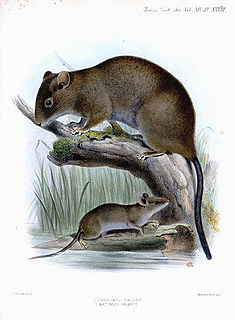Related Research Articles
The Percopsiformes are a small order of ray-finned fishes, comprising the trout-perch and its allies. It contains just ten extant species, grouped into seven genera and three families. Five of these genera are monotypic

Marc Bergevin is a Canadian professional ice hockey executive and former player. He is currently the general manager of the Montreal Canadiens of the National Hockey League (NHL). Bergevin played as a defenceman in the NHL.
Issus may refer to:

Batomys is a genus of rodent endemic to the Philippines. It has six described species.

Oecomys concolor, also known as the unicolored oecomys, unicolored rice rat, or unicolored arboreal rice rat, is a species of rodent in the genus Oecomys of family Cricetidae. It is found in tropical rainforest in the Amazon biome, but its range is poorly documented; it has been recorded in northwestern Brazil, southeastern Colombia, and southern Venezuela.

The Balkan snow vole, also known as Martino's snow vole, is the only member of the genus Dinaromys. Eight subspecies of this vole have been recognized from southern parts of Europe. The genus name means "Dinaric mouse", referring to the Dinaric Alps. The Balkan snow vole is a living fossil, the only living species in the tribe Pliomyini, and might arguably better be placed in Pliomys, a genus established for its fossil relatives even before the Balkan snow vole was scientifically described.

Ricaniidae is a family of planthopper insects, containing over 40 genera and 400 species worldwide. The highest diversity is in tropical Africa and Asia and in Australia, with a few species occurring in the Palearctic. It is one of the smaller families in the planthopper superfamily Fulgoroidea.

Acanalonia is a genus of planthopper in the fulgorid family Acanaloniidae.

Hysteropterum is a genus of planthoppers described by Amyot & Serville in 1843, belonging to the family Issidae, subfamily Issinae.

Issidae is a family of planthoppers described by Spinola in 1839, belonging to the order Hemiptera, suborder Auchenorrhyncha superfamily Fulgoroidea.

Nogodinidae is a family of planthoppers. They have membranous wings with delicate venation and can be confused with members of other Fulgoroid families such as the Issidae and Tropiduchidae. Some authors treat it as a subfamily of the Issidae. Some of their key features are a frons ("face") that is longer than wide and a reticulate wing venation. They are less than 2 cm long. The antenna arises well below the eye, has the base clubbed and flagellum unsegmented. The lateral ocelli are outside the margins of the face. The face has carinae on the edge. On the hind leg, the second tarsal segment has an apical spine arising from it. The tibia of the hind leg also has spines towards the tip. An important family character is found in the shape of the male genital structure, a style that is longer than broad. Most members of this family are forest species.

Caliscelidae is a family of planthoppers, sap-sucking insects that belong to the order Hemiptera, suborder Auchenorrhyncha and superfamily Fulgoroidea. They are somewhat anomalous and have often been included within the family Issidae. Studies made in 2013 of the phylogeny of the Issidae and other groups using molecular techniques support the treatment of the group as a separate family. Sexual dimorphism can be marked. Some members of the family are called piglet bugs due to the shape of their snout. A particularly aberrant genus described in 2011 from India, Formiscurra, has males that resemble ants.

Formiscurra indicus is a species of planthopper in the family Caliscelidae found in southern India. A related species, Formiscurra atlas occurs in southwestern Ethiopia. Like others of its family they have short wings, suck plant sap and escape by leaping. The species shows great sexual dimorphism. The male of this half centimeter-long insect has an enlarged lobe in front of its head, the frons or metope, giving it an ant-like appearance. Females do not have such an enlarged structure but have a slightly long snout and differ slightly in body shape. The species is found mainly on low vegetation in open scrub and grass habitats.

Conosimus baenai is a species of planthopper native to the Iberian Peninsula in Spain. Its coloration ranges between light yellow and greenish-yellow. Males measure about 4.1–4.4 millimeters in length while females measure about 4.7–5.0 millimeters. The species was named after Manuel Baena, a hemipterologist.

Agalmatium flavescens is a species of planthopper belonging to the family Issidae, subfamily Issinae.

Agalmatium is a genus of planthoppers belonging to the family Issidae, subfamily Issinae.
Ommatissus is a genus of bugs in the subfamily Tropiduchinae and the tribe Trypetimorphini.

Acanaloniidae is a family of planthoppers. It is sometimes treated as a subfamily of Issidae.

Formiscurra is a genus of planthopper in the family Caliscelidae with two species Formiscurra indicus of southern India and Formiscurra atlas from southwestern Ethiopia. Like others of its family they have short wings, suck plant sap and escape by leaping. The species shows great sexual dimorphism. The males of this half centimeter-long insect have an enlarged lobe in front of its head, the frons or metope, giving it an ant-like appearance. Females do not have such an enlarged structure but have a slightly long snout and differ slightly in body shape. The species is found mainly on low vegetation in open scrub and grass habitats. It has been suggested, based on the Afro-Indian distribution, that the ancestral species of this and other genera Chirodisca and Rhinogaster, evolved in Eurasia and spread to Africa 5-7 million years ago when the Tethys sea closed and thus their ancestors would have been part of the late Miocene Hipparion fauna.

The Hemisphaeriinae are a subfamily of bugs in the family Issidae, based on the type genus Hemisphaerius. Species in 107 genera have been recorded in most continents, but the greatest diversity appears to be in South-East Asia.
References
- ↑ V.M. Gnezdilov, M.R. Wilson (2008) Revision of the genus Falcidius Stål (Hemiptera: Fulgoroidea: Issidae). J. Nat. Hist. 42: 1447-1475
| | This Fulgoromorpha article is a stub. You can help Wikipedia by expanding it. |